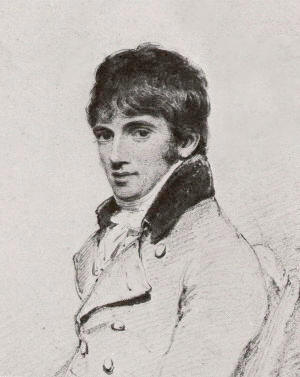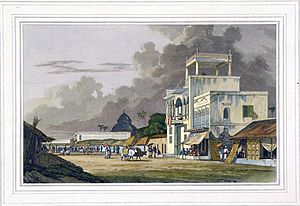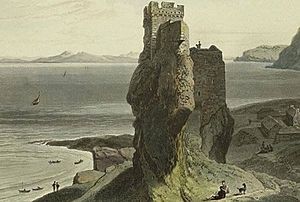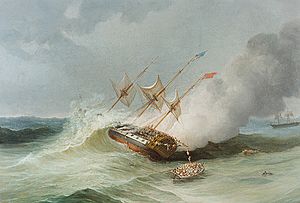William Daniell facts for kids

William Daniell (1769–1837) was an English artist. He was famous for painting landscapes and sea scenes. He also made many prints using a special technique called aquatint. William traveled a lot in India with his uncle, Thomas Daniell. Together, they created a beautiful book called Oriental Scenery. Later, William traveled all around the coast of Britain to paint pictures for another big book, A Voyage Round Great Britain. His art was shown in important exhibitions, and he became a member of the Royal Academy in 1822.
Contents
Early Life and First Adventures
William Daniell was born in Kingston upon Thames, England. His father was a bricklayer. When William was ten, his father passed away. This changed William's life a lot. He went to live with his uncle, Thomas Daniell, who was also a landscape artist.
In 1784, when William was 15, he went with his uncle to India. William helped his uncle by preparing drawings and sketches. William's brother, Samuel Daniell, also became an artist. Samuel traveled to South Africa and later to Ceylon (now Sri Lanka).
Exploring India

William was only 16 when he arrived in Calcutta (now Kolkata) with his uncle. They decided to make a set of twelve prints showing views of the city. Calcutta was growing fast, and they thought people would want to buy pictures of its new buildings. They were new to printmaking, so they got help from Indian artists. The prints were finished in 1788 and sold very well.
After this success, Thomas and William planned a big trip around northern India. They traveled up a river to Bhagalpur. There, they stayed with Samuel Davis, an artist who worked for the East India Company. They continued their journey to places like Delhi, Agra, and Mathura. The next year, they even made a special trip to the Himalayas.
In 1791, they returned to Calcutta. They held a lottery to sell their artworks. They used the money to travel to southern India. They visited many hill-forts and huge, beautiful temples. These included temples at Madurai and Rameswaram. After another lottery in Madras (now Chennai), they went to western India. In Bombay (now Mumbai), they met another artist, James Wales. He showed them amazing cave temples like Elephanta and Karli.
Back in England
In September 1794, William and his uncle returned to England. William had kept a detailed diary of their travels in India. This diary is now kept in the British Library. After 1794, William stopped writing in his diary. So, most of what we know about his later life comes from the diary of his friend, Joseph Farington, who was also an artist.
When they got back, William and his uncle lived together in London. Their first goal was to publish their Indian paintings. They turned these paintings into aquatint prints. William worked very hard to improve his aquatint skills. Farington's diary says that William spent seven years working from early morning until midnight to perfect his techniques.
Famous Artworks and Success
The Daniells' most famous work about India was Oriental Scenery. It was published in six parts from 1795 to 1808. This collection had 144 colored aquatint prints. It was a huge success, both artistically and financially. Even the East India Company bought many sets.
A magazine called Calcutta Monthly praised their work. It said that the drawings were "masterly" and showed India very realistically. It added that you could almost "feel the warmth of an Indian sky" and see the water "in actual motion." This book helped people in Britain imagine India as a romantic and beautiful place.
William Daniell also made 72 etchings of famous artists and people in London. These were published from 1804 onwards. Many of these portraits are now in the National Portrait Gallery.
A Voyage Round Great Britain
In 1813, Daniell started his biggest art project: A Voyage Round Great Britain. He planned to travel all around the coast of Britain. He wanted to draw interesting places and write about the scenery and the people. He had already traveled in England, Wales, and Scotland, so he knew where to find good subjects for his paintings.
At first, he wanted to travel by sea, but it was too difficult. So, most of his journey was done by road. He completed the trip in six separate parts between 1813 and 1823. In 1813, he and his friend, Richard Ayton, traveled from Land's End to Holyhead. Ayton wrote the text for the first part of the book. After that, Daniell did both the sketching and the writing himself.
Daniell would make pencil sketches of interesting views. He would add notes about colors and textures. He included people and landscapes in his drawings. Back in London, he would turn these sketches into aquatint plates. This was a very delicate and skillful process. He would then print and color the pictures. It's amazing that he could remember all the details, as sometimes five years passed between his sketches and the finished prints!
In 1815, Daniell traveled north to Scotland. He got advice from many people in Edinburgh, including the famous writer Walter Scott. Scott not only told him where to visit but also gave him ideas for the book's text. Friends in Edinburgh also gave him letters to people who could offer him a place to stay. This was important because there were not many good inns back then.

In July and August 1815, Daniell explored many islands, including Eigg, Rum, Skye, and Raasay. He also visited the Hebridean Islands of Harris and Lewis. He continued up the west coast of Scotland, around the north, and out to the Orkney Islands. Then he traveled down the east coast to Dundee. He had not planned to cover so much in one trip, but the weather was perfect for an artist. This huge journey resulted in 139 aquatint prints.
He continued his travels in 1821, 1822, and 1823, covering more of the British coast. The final prints for A Voyage Round Great Britain were published in 1825. The complete set had 308 prints and was published in eight volumes.
While working on the Voyage, Daniell also painted for art exhibitions. Many of his oil paintings were of Scottish scenes. His paintings and aquatints for the Voyage were considered very high quality. He was especially good at showing the atmosphere and light in his sea scenes. In 1822, after many years of hard work, Daniell was finally elected a Royal Academician.
William also created many marine (sea) paintings. One famous one is The Burning of the "Kent". It shows the dramatic loss of a ship called the Kent and the rescue of many people. He also painted battle scenes, winning a prize for his paintings of the Battle of Trafalgar. Later in his life, he started painting large panoramic scenes, including one of Madras that showed how people tamed wild elephants.
Daniell's last great artworks were made between 1827 and 1830. He became interested in the scenery around Windsor. He painted five oil paintings of Windsor Castle and its surroundings. He also painted two oil paintings of Virginia Water. These were thought to be some of his best oil paintings. He also made 12 aquatints of these Windsor scenes. People say these are some of the finest aquatints ever made.
William Daniell continued to work until he passed away on August 16, 1837. His house in Camden Town, London, has a special plaque to remember him.
In 1962, a surprising discovery was made. 306 of the original 308 copper plates that Daniell used for A Voyage Round Great Britain were found! They had been missing for over 100 years. These plates are now owned by the Tate museum. They are a great reminder of Daniell's hard work and amazing skill in aquatinting.
Published Works
Here are some of the books and prints William Daniell published:
- Voyage to India
- Zoography
- Animated Nature
- Views of London
- Views of Bootan (based on his uncle's sketches)
- A Voyage Round Great Britain (his biggest project)
Collections
William Daniell's artworks can be found in many art collections around the world, including:
- National Portrait Gallery, London
- Royal Academy of Arts, London
- National Maritime Museum, London
- Courtauld Institute of Art, London
- Yale Center for British Art
- Fine Arts Museums of San Francisco
- National Museums and Galleries of Wales, Cardiff
- Indianapolis Museum of Art, USA
- Falmouth Art Gallery, UK
- Dallas Museum of Art, Texas
- Watford Museum, UK
- National Museum of India, New Delhi
Images for kids
-
Sambhal Jama Masjid (1789). A drawing by Thomas Daniell and William Daniell
-
A view of the Canton factories (around 1805–10)
-
Windsor Castle from Brocas Meadow (1827)










